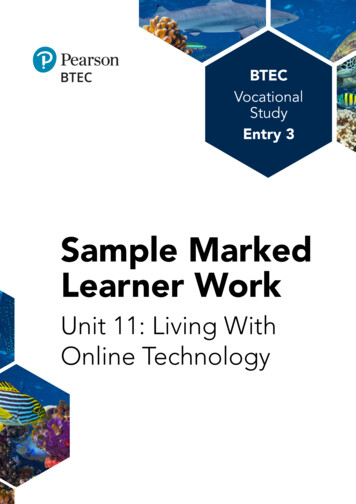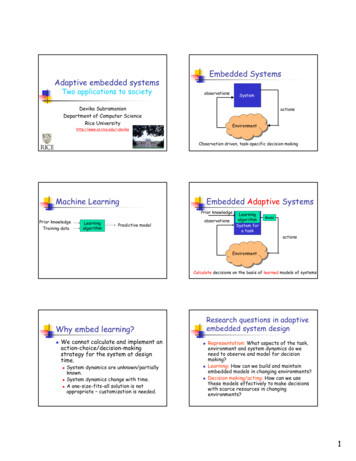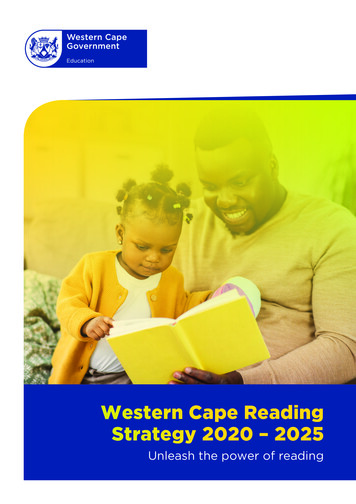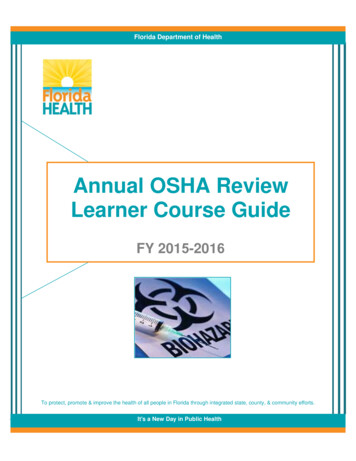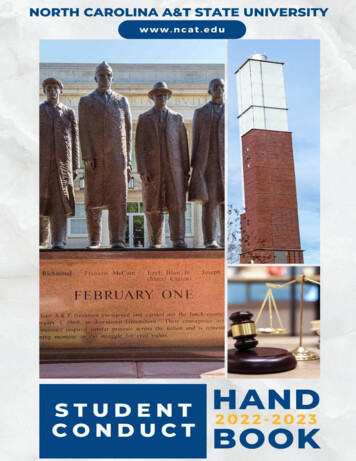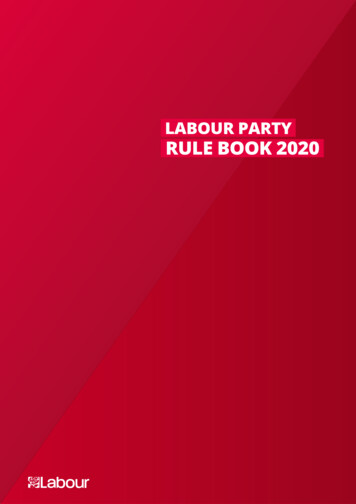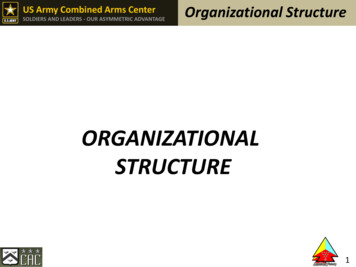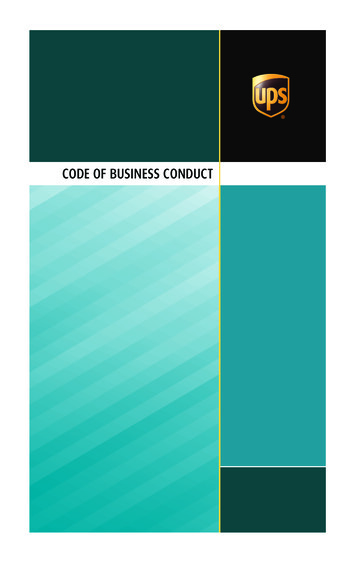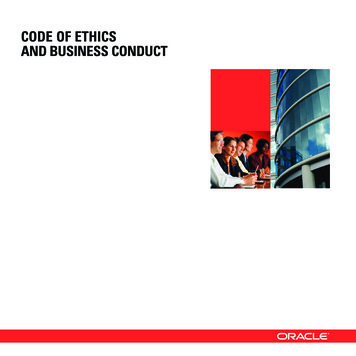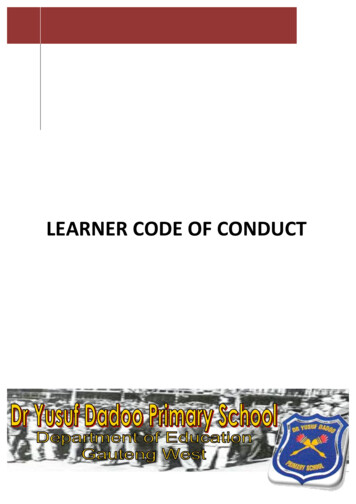
Transcription
LEARNER CODE OF CONDUCT
TABLE OF CONTENTSNO.TOPICPAGE gislative FrameworkPurpose/ AimDefinitionAdoption of Code of Conduct for LearnersFeatures of the Code of Conduct for LearnersMain Provisions of the Code of Conduct for LearnersInfringements of the Code of ConductSchool RulesTransportSchool Enrichment ProgrammeAccommodation of Religious or Cultural RightsWhat is MisconductDue ProcessSerious Misconduct and the LawThe Rights of LearnersResponsibility of LearnersResponsibility of Parents with respect to the Code of ConductDisciplinary SystemGrading of OffencesDisciplinary ProceduresDisciplinary InterventionsSuspension of a learner by the principal or deputyprincipal as a pre-cautionary 0313233Disciplinary and Tribunal HearingProcedure during HearingProcedures for monitoring this policyTools to be usedProcedures for non-compliance of this policyDate of formulationDate of review and terminology updateRatification by SGB/ SMTRatification by District DirectorAnnexuresAnnexure A:Learner CommitmentAnnexure B:Table 1: List of offences per grade of offenceTable 2: List of the possible disciplinary sanctions tobe applied for Grade 1, 2, 3 and 4 offences,respectivelyAnnexure C:Written WarningAnnexure D:Final Written WarningAnnexure E:Notice of Disciplinary HearingRights of Learner facing Disciplinary ActionAnnexure F:Record of Disciplinary HearingAnnexure G:Lodging of Appeal (Review form)141516161616161717182Lodging of Appeal (Re
1. PREAMBLEDr Yusuf Dadoo Primary School is committed to providing an environment that is conducive toteaching and learning by:§§§§Promoting the rights and safety of all learners and educators and parents.Ensuring learners’ responsibility for their own actions and behaviour.Prohibiting all forms of unfair discrimination and intolerance.Eliminating disruptive and offensive conduct.The Code of Conduct spells out the rules regarding learner behaviour at school and describes thedisciplinary system to be implemented by our School concerning transgressions by learners. The codeof Conduct applies to all learners while they are on the School premises or when they are away from theSchool representing it or attending a School function.Section 8(4) of the SA Schools Act provides that all learners attending a School are bound by the Codeof conduct. All learners attending the School are expected to sign a statement of commitment to theCode of Conduct (Annexure A). The administration of the Code of Conduct is the responsibility of theDisciplinary committee of the School.2. LEGISLATIVE FRAMEWORK§§§§South African Schools Act 84 of 1996Gauteng Schools Act 6 of 1995Relevant CircularsTirisano Documents3. PURPOSE/AIM OF THE CODE OF CONDUCT§§§§§§§§§§§To ensure that the vision and mission of the school is achievedTo protect the rights of learners and educatorsTeaching takes placeSchool is free from drugs, gangs, bullying, sexual abuse etc.All the learners, educators and parents are aware of the Code of Conduct at schoolRespect propertyPromote culture of tolerance and respect for the human rights of others.To facilitate learning and teaching at schools.To ensure that there is order and discipline in schools.To promote and clarify the roles and responsibilities for learners.To provide for legitimate disciplinary measures.3
4. DEFINITIONCODE OF CONDUCTThe Code of Conduct is a document that lays down clear guidelines about what is acceptable andunacceptable behaviour in a school. It is similar to the school rules. The aim of the School’s code ofconduct is: Create a proper learning environment .In the past schools depended on meting out corporalpunishment as a way of enforcing compliance. But the Constitutional Court has outlawed corporalpunishment in line with the South African School Act (SASA) act No 84 of 1996s(10)(1). The code ofConduct principle was laid down in SASA, where it was stated that the function of a Code of conduct is:“to establish a disciplined and purposeful school environment”.5. ADOPTION OF CODE OF CONDUCT FOR LEARNERSThis Code of conduct is an integral part of the school Policy and must be adoptedby all stakeholders for “ownership” purposes.6. FEATURES OF THE CODE OF CONDUCT FOR LEARNERSConsists of the following:§§§§§§§Aims of the code of conductResponsibilities of learnersResponsibilities of Educators with regard to learnersResponsibilities of Parents with regard to learnersSchool rules, regulations and ProceduresThe scope of the Code of Conduct and its Legal implicationsDisciplinary Procedures.7. THE MAIN PROVISIONS OF THE CODE OF CONDUCT FOR LEARNERS:The primary factor dictating behaviour of learners is that they should at all timesbe committed to their responsibilities of learning at school. This implies that theirbehaviour has to constitute a disciplined and tolerant manner of dealing with eachother, with the teachers as well as the environment.8. INFRINGEMENTS OF THE CODE OF CONDUCT:Dealing with infringements must always be informed by the followingFundamental principles:§§§The disciplinary process must be fair, just, corrective and educative.Avoid public humiliation.The parent/guardian of the student must be informed and be involved in the process of correctingthe behaviour.4
9. SCHOOL RULESThe School rules are intended to establish a disciplined and purposeful environment to facilitateeffective teaching and learning at our School. Nothing shall exempt a learner from complying with theSchool rules. Ignorance of School rules is, therefore, not an acceptable excuse.9.1 GENERAL PRINCIPLES§§§§Learners are expected at all times to behave in a courteous and considerate manner towards eachother, all members of staff and visitors to the School.Learners are expected to abide by the School rules with regard to appearance and behaviourwhen representing the School both during School hours and after School hours, at school andaway from School. Learners may not say or do anything that will discredit themselves or theSchool.No learner has the right at any time to behave in a manner that will disrupt the learning activityof other learners, or will cause another learner physical or emotional harm.The School will contact parents/guardians when a learner’s behaviour becomes a cause ofconcern and will endeavor, in a spirit of constructive partnership, to resolve the problem.9.2 SCHOOL AND CLASS ATTENDANCEParents/guardians, learners, teachers and School Governing Body (SGB) members are jointlyresponsible for ensuring that all learners attend School.§§§§§§§§§If a learner does not attend School regularly, the relevant grade educator will report the absenceof the learner to the parent and the Principal in writing. The educator must keep an accurateregister of learner attendance and must keep copies of all communication to parents whenabsence from the classroom is reported.All learners are to arrive at School before the official starting time. Learners who are late forSchool will be marked absent as registers are completed at the beginning of each School day.Absence from a class, without the permission of the educator or subject educator, is prohibited.Any absence from School must be covered by an absentee note from a parent/guardian.Should a learner be absent from School for a period of three (3) days or longer, this leave ofabsence must be supported by a letter from a medical doctor/traditional doctor/ registeredherbalist.Any absence from a formal examination, test or task must be supported by a letter from amedical doctor/traditional doctor/registered herbalist.No learner may leave the School during School hours without a letter from a parent/guardianrequesting the release of their child and the permission of the Principal/Deputy Principal; /GradeHead from whom an exit notes must be obtained.Truancy from School is prohibited.All learners will attend assembly for the full duration thereof.5
9.3 SCHOOL UNIFORM AND GENERAL APPEARANCE§§§§§§§§§§§§§§Learners are expected to wear the official School uniform and appear neat and tidy at all times.No additions to the uniform that are not in accordance with the regulations will be allowed (e.g.beanies).No earrings, jewellery, accessories, colour contact lenses or visible tattoos are allowed.No colouring of hair or wearing of exotic hairstyles and braids are not allowed.No hair accessories e.g. alice-bands, coloured hair grips and bandsFingernails must be kept trimmed short and clean at all times. Nail polish is not allowed.During events that allow the wearing of casual wear, learners should wear neat, presentableclothes. Beachwear, tight-fitting clothes, clothes that are see through and/or too revealing arenot allowed. Hair, shoes and accessories should be neat at all times.Only learners that have applied, submitted relevant supporting documents and received thenecessary permission from the School (may deviate from official School uniform for religiousand cultural reasons).Girls scarves must be navy blueBoys topees must be white or navy blueKurtas must be navy bluePE uniform includes a white T-shirt, navy blue tracksuit pants and white/black takkies.Takkies are not allowed to be used with formal uniformNavy blue blazers are allowed to be used9.4 VALUABLES AND PERSONAL BELONGINGSThe School will not be held responsible for theft of or damage to personal belonging on school premises(e.g. cell phones, bags, books and clothing).§§§§Learners should not bring cell phones, large sums of money and valuables to School. Cellphones may not be switched on during a normal School day. If the learner brings a cell phone toSchool, the learner must carry a written request from the parent, which must provide for anindemnification against loss of or damage to the cell phone.If a parent requests a learner to pay School fees on his/her behalf, such School fees should bepaid before the start of the School day.Arrangements should be made with the teacher in charge for safekeeping or valuables, etc.during sports practices.Learners may not bring computer games, iPods or similar electronic devices to School.9.5 GENERAL RULESGolden Rule: One person speaks at a time§§§§§§Loitering and/or playing in and around the corridors, stairs and toilets is forbidden.All litter must be placed in refuse bins or wastepaper baskets.Willful damaging, vandalizing or neglect of School property and the property of others, either bywriting or by a physical act, is prohibited. Theft of School and private property is alsoprohibited.Any act of cheating in class work, homework, informal and formal tests or internal or externalexamination is prohibited. Furthermore, copying of and/or borrowing another learner’s work isforbidden.Disruptive, unruly, rude and/or offensive behaviour will not be tolerated.The timeous handing in of work is the responsibility of each learner.6
§§§§§§§§§§Learners who fail to produce a medical certificate on absenteeism during formalexaminations/tests/assessment tasks will obtain a mark of “o” (nought) for the particularexaminations/test/assessments task.The learner will respect his beliefs, culture, dignity and rights of other learners, as well as theirright to privacy and confidentiality.Language that is seen as discriminatory or racist is prohibited.Any act that demeans or humiliates another learner’s culture, race or religion is prohibited.All learners have the right to an education free of interference, intimidation and/or physicalabuse. The learner will respect the property and safety of other learners. Fighting or threateningof other learners is forbidden.The learner will respect those learners in positions of authority. A learner who is in a position ofauthority will conduct him/herself in a manner befitting someone in authority. She/he willrespect the rights of other learners and will not abuse such authority bestowed upon him/herthrough his/her position.The carrying, copying and/or reading of offensive material are prohibited.Learners must keep clear of areas that are indicated as out of bounds. These include:The playing fields Electrical mains distribution boxes, fire extinguishers and hoses.Parking lots.9.6 RULES GOVERNING PUBLIC PLACESThe School is a place of safety where laws pertaining to public spaces are applicable.§§§§No dangerous objects or illegal drugs as defined in the SA schools Act will be brought ontoand/or used on the School property unless authorized by the Principal for educational purposes.Dangerous objects include knives, firearms or any item that could harm a person.The carrying and /or smoking of cigarettes in prohibited.Alcohol is not permitted on School premises or during any School activity.The carrying of and/or consumption of illegal chemical substances and drugs is prohibited.10. TRANSPORTLearners wishing to park their bikes on the School premises must first obtain permission from theSchool to do so and make use of the areas specifically demarcated for this purpose.All learners park their bikes (pedal or motorized) on the School premises at their own risk.Specific areas are provided for the safekeeping of bikes, etc, and must be used by learners.The code of Conduct is applicable when making use of public transport to and from School.Learners may not hitchhike while in School uniform, whether formal or sports dress.11. SCHOOL ENRICHMENT PROGRAMMEInvolvement in activities making up the School Enrichment PROGRAMME forms a valuable andintegral part of the holistic education of every learner. All learners are, therefore, expected to becomeactively involved in at least on (1) sport or cultural activity per term.§§§The learner is expected to adopt the correct etiquette pertaining to the specific activity at alltimes.Once a learner has committed him/her to an activity; she/he will be bound to meet the rules andobligations related to that activity.Involvement in a particular activity will span the entire season/duration in which that activitytakes place.7
§§§§§§Attendance of all practices is compulsory. Missing a practice without a valid excuse in writingfrom the learner’s parents may result in the learner being suspended from participation in one (1)inter-school league fixture.Appropriate kit/uniform will be worn to practices.The correct match kit/uniform will be worn to inter-school league fixtures.Learners travelling to an away fixture will travel in full School uniform, unless otherarrangements have been made.Sports and other kit must be carried in an appropriate bag.Learners playing in home league fixtures may arrive at the venue in their appropriate sportskit/uniforms.12. ACCOMODATION OF RELIGIOUS OR CULTURAL RIGHTSReligious practices, conduct or obligations that relate to the core values and beliefs of a recognisedreligion and that are in conflict with any rule contained in this code of Conduct will be accommodatedby a deviation from this Code of conduct by the Governing Body under the following conditions:§§§§§§§§§§The Learner, Assisted by the parent, must apply for a deviation from the standard School rules ifsuch rules are in conflict with or infringe on any religious right of the learner.This application must be in writing and must identify the specific rule/s that is/are offensive tothe learner’s religious right/s as contained in the Constitution of the Republic of South Africa.This application must include a reasonable interpretation of the religious right that the learnerfeels are offended and a suggestion on how the rules may be supplemented by the GoverningBody to accommodate such religious rights.The learner must provide proof that she/he belongs to that specific religion and THAT THERELIGIOUS PRACTICES, RULES AND OBLIGATIONS THAT ARE IN CONFLICT WITHTHE Schools Code of Conduct are his/ her true beliefs and commitments.The religious conduct or practice must be lawful.The Governing Body will consider the application and, if it is satisfied that the application isjustified in terms of Constitutional principles, the application will be granted in writing.When Governing Body allows for deviations from the standard rules, such deviations must bebased on core religious beliefs inherent to the religion, and it must be compulsory for the learnerto comply with such beliefs.The deviation must specify the extent of the exemption from the normal rules and must clearlyidentify the conduct that will be allowed – e.g. the wearing of a head scarf, including colours anddetails of design; the growing of a beard; or the wearing of a specific hairstyle or jewellery – andthe conditions under which such deviation will be applicable to the learner.Cultural rights will be considered in the event that they do not relate to a religion, if such culturalrights manifest in conduct of a permanent nature that is compulsory for the cultural group. Thisrefers to cases where the removal of the cultural jewellery or mark will cause considerable painto the learner. Normally, cultural rights are exercised through marks and expressions of atemporary nature that are justified for a specific cultural gathering. The learner must convincethe Governing Body that his/her cultural rights can be exercised only through a permanentintervention.Any request for a deviation from the Code of conduct based on cultural rights must be in writing.13. WHAT IS MISCONDUCT“Misconduct: means misconduct committed by a learner and includes the following:Ø misconduct committed on the premises of a school, whether during or outside of school hours:Ø misconduct committed during any school activity, irrespective of whether it is committed within oroutside the school premises, and during or outside of school hours; and8
Ø any conduct, committed in or out of school uniform and within or outside the school premises,Which:Ø tends to bring the school into disrepute;Ø interferes with the governance, authority and proper administration of the school;Ø interferes with the conditions necessary for any school activity;Ø subject to the reasonable exercise of the right to assemble, demonstrate, picket and petition asprovided in the constitution, 1996 and the code, is committed with the intention of preventing anyperson from exercising his or her rights, powers or duties as a member of the school community, oris committed in retaliation against such exercise; orØ is prohibited by the code of the school; “prosecutor’ means the principal of the school or aneducator appointed by the principal to present the case against a learner; “representative” meansa parent of a learner, a co-leaner or any other person chosen by the learner to represent the leanerat a disciplinary hearing:“School days” means days of the week, excluding Saturdays, Sundays, public holidays and schoolholiday;“Serious misconduct” means misconduct as contained in Schedules 1 and 2:14. DUE PROCESSDUE PROCESS guarantees a learner a fair hearing before a learner may besuspended for a period of one week or be expelled from the school by the Head ofthe Education Department. The SGB will keep a record of the proceedings of thehearing. During the hearing the learner will be allowed legal representation.15. SERIOUS MISCONDUCT AND THE LAWSerious misconduct will be investigated by the police and handled in terms of theGovernment notice and regulations promulgated by the Members of theExecutive Council in the Provincial Gazette of the provinces concerned.16. THE RIGHTS OF LEARNERSDemocracyØ All learners and partners at school have the democratic right to due process and toparticipate in decision – making about matters affecting them at school.Non-Discrimination and EqualityØ No person may unfairly discriminate against a learner.Privacy, respect and dignityØ Every learner has inherent dignity and has the right to have his/her human dignityrespectedNon-violence and the freedom and security of a personØ Every learner has the right not to be treated or punished in a cruel, inhuman or degradingmanner. Corporal punishment has been abolishedØ Learners have the right not to be locked up in solitary confinement or detention9
Freedom of expression and right to demonstrate present petitionsØ This includes the right to freedom is not absolute.Vulgar words, insubordination andinsults are not protected speech. When the expression leads to disruption in school, thisright can be limitedØ Learners have the right to agreed procedures with the SGB for expressing and resolvingschool-related grievances. Problems or issues should, as far as possible be resolved atschool.School EnvironmentØ Learners have the right to a clean and safe environment that is conducive to education.EducationØ The South African Schools Act provides that education is compulsory for learners fromthe year in which such learners reach the age of 7 years until 15Ø In cases of suspension and expulsion, placement in an alternative school settingØ Education and learning can be successful, learners have to be committed to selfdevelopmentØ The right to education includes the right to attend all classes, to learn and be taught in allapproved subjects, to be informed about school progress and to make use of all schoolfacilities.17. RESPONSIBILITIES OF LEARNERSSchool and Classroom RulesClassroom rules are designed to give effect specifically to the relationship between educators andlearners in the classroom. All learners will to be provided with a copy of the classroom rulesØ Learning and School workØ Learners must commit themselves to do their work during classes, completedØ assigned homework and catch up on work missed because of absence. DisruptionØ at school is unacceptable.Security and Care of School PropertyIt is the privilege and obligation of every learner to protect and carefully use all the facilities andequipment so that others that come after them can also enjoy the privilege.The parent or legal guardian of anyone who intentionally misuse, damages or defaces any schoolproperty should replace it or pay for the property which has been damaged.School AttendanceØ Learners to attend school regularly during school hours.Should a learner be absenthis/her parent or legal guardian must notify the school to explain his absenceØ Learners should actively participate in the learning process and decision making and havethe opportunity to talk about their problemsØ There should be a relationship of mutual trust and respect between learners and educatorsØ The RCL should represent the interests and views of the learners within the school.10
18. RESPONSIBILITES OF PARENTS WITH RESPECT TO THE CODE OFCONDUCTThe ultimate responsibility for learner’s behaviour rest with their parents or guardians. Parents areexpected toØ Support the school, and require learners to observe all school rules and regulations andaccept responsibility for any misbehavior on their partØ Take and active interest in their children’s school work and make it possible for thechildren to complete their homeworkØ Parents should attend meetings.19. DISCIPLINARY SYSTEMAll learners will abide by the disciplinary system that has been developed to assistand guide learner behaviour in the school.20. GRADING OF OFFENCESOffences are graded according to the nature and degree of seriousness of theoffences, of which Grade 4 offences are the most serious. See Annexure B, Table1 for a list of offences making up each of the grades 1, 2, 3 and 4.21. DISCIPLINARY PROCEDURES:The grade of an offence will determine the procedure to be followed.Ø Grade 1 offence – a written warning followed by a final written warning, then adisciplinary hearing.Ø Grade 2 offence – a final written warning followed by a disciplinary hearing, then atribunal hearing.Ø Grade 3 offence – a disciplinary hearing or a tribunal hearing (depending on theseverity of the particular offence).Ø Grade 4 offence – offence immediately reported to the South African Police Service(SAPS) and a tribunal hearing.GRADE 1: OFFENCES1. All grade 1 offences will be dealt with by the educators who must keep a written record of suchoffences and the disciplinary measure taken.2. When a third grade 1 offence occurs, the matter is referred to the Grade Head along with therecord of all three (3) offences and the Grade Head will issue a written warning. A signed copyof acknowledgement will be kept on record by the Grade Head and communicated to theparent/guardian.11
3. Should the particular Grade 1 offence recur after disciplinary intervention has occurred and awritten warning has been issued, the staff member will, in consultation with the Grade Head,arrange an interview with the learner. A final written warning will be issued .A signed copy ofacknowledgement will be kept on record by the Grade Head and communicated to theparent/guardian.4. The Grade Head will keep on record copies of all relevant documentation relating to the offencesand the disciplinary measures imposed and provide copies thereof to the learner’s gradeeducator.GRADE 2: OFFENCES1. All Grade 2 offence will immediately be referred to the Grade Head. The staff member will, inconsultation with the Grade Head, arrange an interview with the learner. A final written warningwill be issued and disciplinary action applied. A signed copy of acknowledgement will be kepton record by the Grade Head and communicated to the parent/guardian.2. When a second Grade 2 offence occurs after a final written warning has been issued for the firstoffence, the Grade Head will refer the matter to the Disciplinary committee for a disciplinaryhearing. The parent/guardian will be advised in writing, a minimum of five (5) days before thedesignated date that an internal disciplinary hearing has been convened.3. Should the particular Grade 2 offence recur after the issuing of a final written warning and adisciplinary hearing has occurred, the Disciplinary Committee will refer the matter to a tribunalhearing. The parent/guardian will be advised in writing, a minimum of five (5) days before thedesignated date that a tribunal hearing has been convened.4. The Grade Head will keep on record copies of all relevant documentation relating to the offencesand the disciplinary measures imposed and provide copies thereof to the learners register teacher.GRADE 3: OFFENCESAll Grade 3 offence will immediately be reported to the Grade. The Grade Head will refer the matter tothe Disciplinary Committee who will, depending on the severity of the offence, determine whether toconvene a disciplinary hearing or a tribunal hearing. The parent/guardian will be advised in writing, aminimum of five (5) days before the designated date that a hearing has been convened.GRADE 4: OFFENCESAll Grade 4 offence will immediately be reported to the Grade Head. The Grade Head will refer thematter to the Principal who will immediately file a report with the SAPS and convene a tribunal hearing.The parent/guardian will be informed immediately of the offence and be advised in writing, a minimumof five (5) days before the designated date that a hearing has been convened.22. DISCIPLINARY INTERVENTIONSThe following list of interventions and corrective measures used by the School are aimed at correctingbehaviour before suspension and expulsion:1. A verbal warning/reprimand to express disapproval.2. Written warning.3. Final written warning.12
4. Removal from classes to the exclusion room.5. Written punishment.6. Community service to improve the physical environment within and around the School property.7. Homework detention.8. Supervised schoolwork.9. De-merit detention.10. Referral for counselling.11. Attendance of a relevant life skills programme.12. Fines to compensate for damages, to cover the cost of repair or replacement of the lost ordamaged item, and/or the accumulated fine.13. Temporary suspension of library card and/or other School-related privileges.14. Exclusion from School activities and functions, e.g. academic award ceremony.15. Withdrawal of recognition, e.g. award.16. Temporary suspension from class or School, pending disciplinary hearing.17. Disciplinary hearing.18. Tribunal hearing.Failure to comply with interventions and corrective measures will lead to further interventions andmay lead to the offence being categorized at a higher grade. Expulsion may be recommended for aGrade 3 and a Grade 4 offence. See Annexure B, Table 2 for a list of the possible disciplinarymeasures to be applied for Grade 1, 2, 3 and 4 offences respectively.Conduct that may lead to suspension/exclusion includes, but is not limited to, the following:Ø Conduct that violates the rights or safety of others.Ø Criminal behaviour of any kind.Ø Defacing or destroying school property.Ø Disrespectful or objectionable conduct and verbal abuse directed at teachers, other schoolemployees or fellow learners.Ø Outright defiance of lawful requests or instructions issued by persons in authority.Ø Indulging in harmful graffiti, racism or hate speech.Ø Immoral behaviour or profanity.Ø Possessing, using or displaying evidence of use of any narcotics, unauthorized drugs,alcohol or any other intoxicant.Ø Repeated infringements of the school rules or the code of conduct.Ø Possession of dangerous weapons (guns, knives and other objects which may threaten thelives of learners/teachers).1. Should a learner be found guilty by a court of law for breaking the law of the Republic of SouthAfrica, the school has the right, after a fair hearing through the Governing Body, to recommendexpulsion to the Provincial Department of Education.2. A tribunal hearing will be convened with a view to recommending expulsion. In such instancesthe recommendation for expulsion will be submitted to the Provincial Head of Education toapprove the decision.3. Where approval for expulsion is not granted, learners will attend counselling or the relevant lifeskills programme before they may return to class. Such learners will be accommodated in the13
exclusion room in the interim to continue with school work until they have completed the seriesof counselling sessions or the
3 1. PREAMBLE Dr Yusuf Dadoo Primary School is committed to providing an environment that is conducive to teaching and learning by: § Promoting the rights and safety of all learners and educators and parents. § Ensuring learners' responsibility for their own actions and behaviour. § Prohibiting all forms of unfair discrimination and intolerance. § Eliminating disruptive and offensive .
